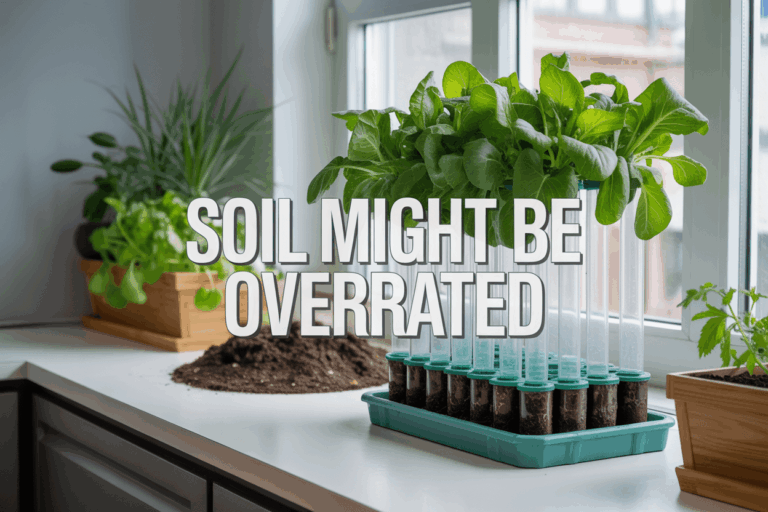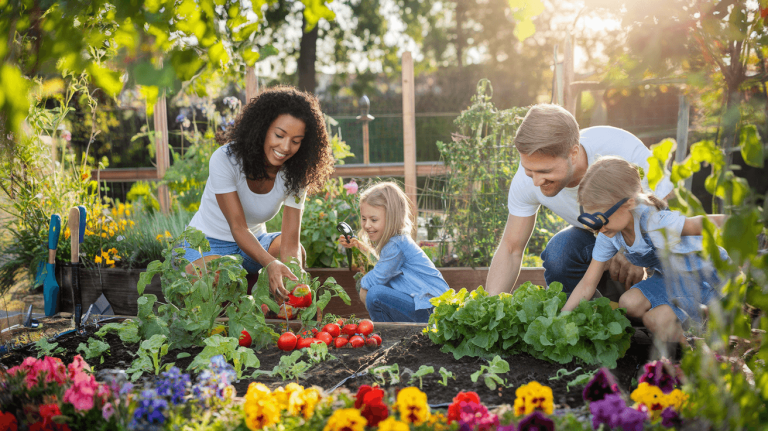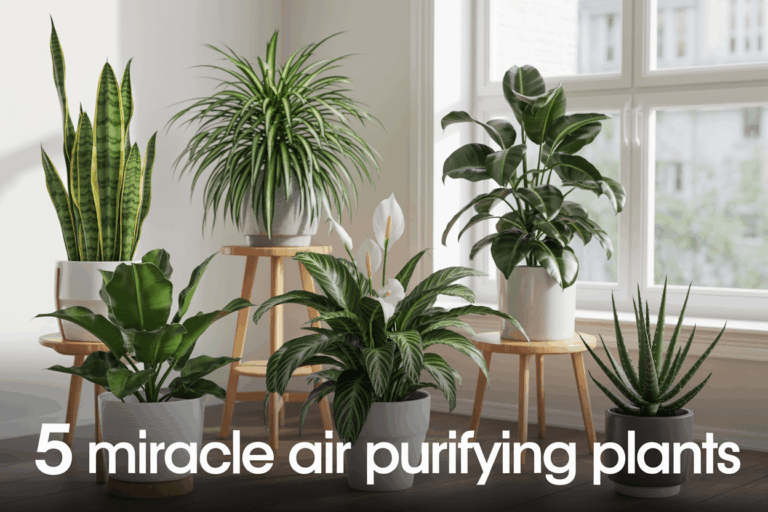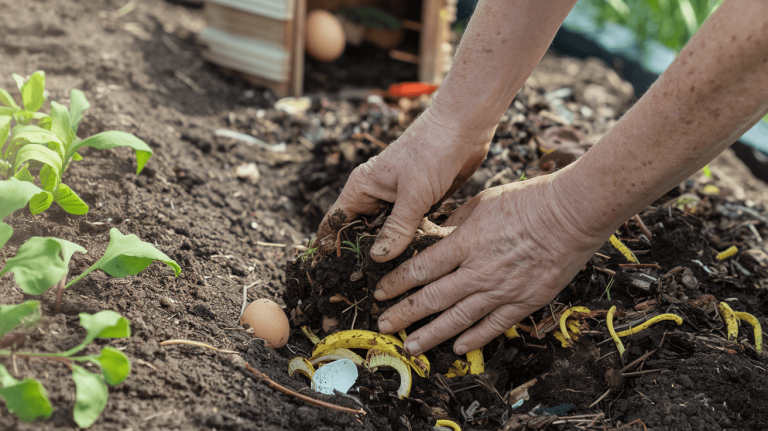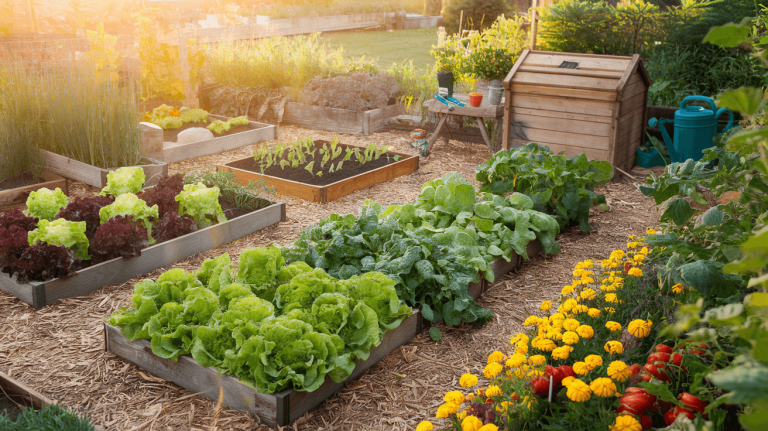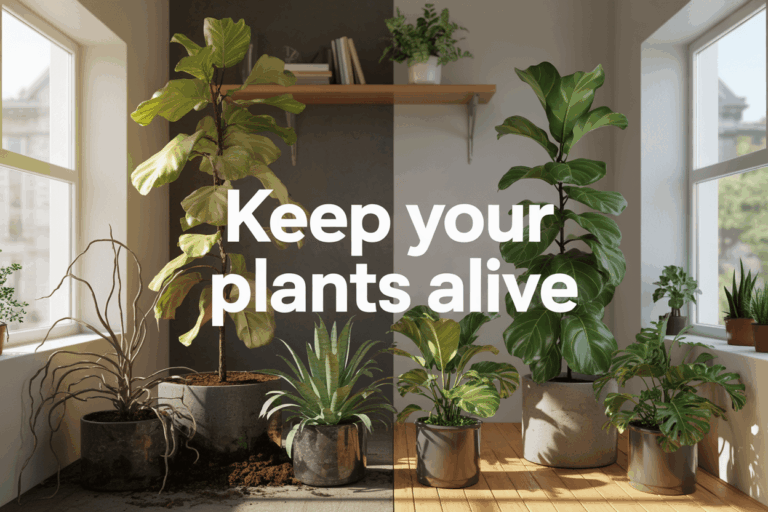7 technics to grow a thriving garden in small spaces
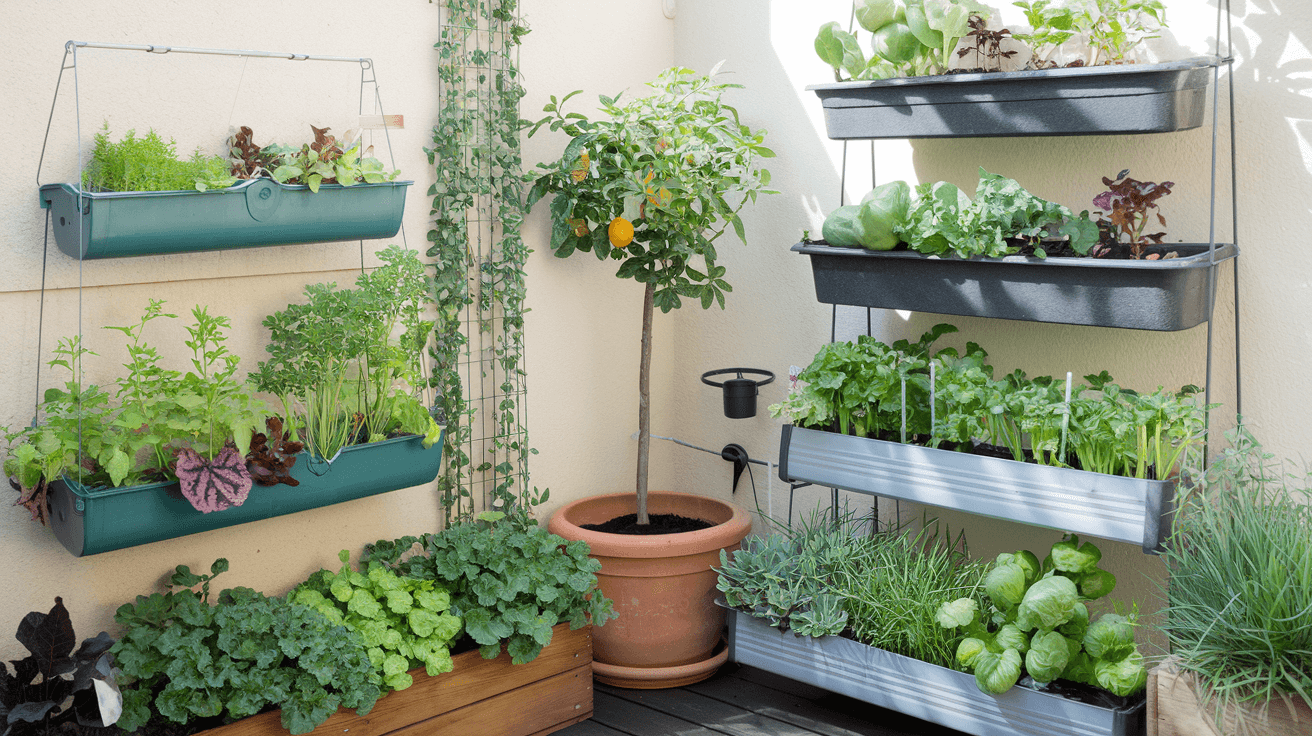
Ever feel like your home gardening dreams are too big for your tiny apartment? You’re not alone. The average urban dweller has less than 100 square feet of potential growing space, yet craves the satisfaction of harvesting their own food.
I’m about to show you exactly how to grow a thriving garden in small spaces without needing a country estate or landscaping degree.
The secret? Thinking vertically and making strategic plant choices. My fire escape garden yielded 30 pounds of produce last year in just 12 square feet.
But here’s what most container gardening guides miss completely: it’s not about cramming as many plants as possible into tiny pots. It’s about creating ecosystems in miniature.
And the difference between those two approaches? That’s where the magic happens.
Choosing the Right Container Solutions for Urban Gardening
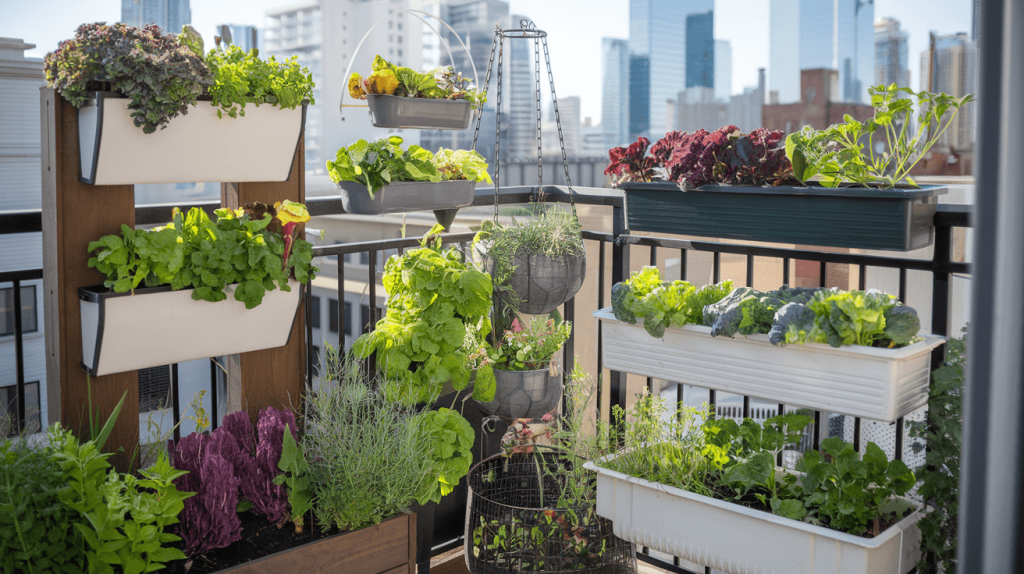
A. Space-saving containers that maximize growth potential
Think you need a sprawling backyard to grow food? Think again. I’ve grown tomatoes in five-gallon buckets that produced more than my neighbor’s garden patch!
Smart container choices make all the difference in garden in small space. Self-watering containers are game-changers – they maintain consistent moisture levels and reduce your workload. Many hold water reservoirs at the bottom that plants can draw from as needed.
Fabric pots (also called grow bags) are perfect for apartment dwellers. They’re lightweight, fold flat for storage, and actually prevent roots from circling, which means healthier plants. Plus, you can place them practically anywhere!
Stacking planters are brilliant space-maximizers. These tiered systems let you grow multiple plants in the footprint of one pot. Some even rotate for better sun exposure.
B. Vertical gardening systems for wall and fence utilization
Those bare walls are prime gardening real estate you’re not using! Pocket planters attached to walls create instant vertical gardens. Some have built-in irrigation systems that water multiple pockets with one pour.
Trellis systems transform ordinary containers into vertical growing machines. Cucumbers, peas, and beans naturally climb, saving you precious floor space.
Wall-mounted rain gutters? Absolute genius for growing shallow-rooted plants like lettuce and strawberries. Just drill drainage holes, cap the ends, mount securely, and you’ve got a sleek growing system that barely protrudes from the wall.
Modular panel systems are worth the investment if you’re serious about vertical growing. These professionally designed units often include built-in irrigation and can transform an entire wall into a lush garden.
C. Hanging planters that create aerial garden spaces
The air above your head is valuable growing space! Macramé hangers have made a huge comeback, and they’re perfect for trailing plants like pothos or strawberries. The natural cotton complements plants beautifully.
Upside-down planters are brilliant for tomatoes and peppers. The plants grow downward through holes in the bottom, saving floor space and keeping fruits off the ground.
Pulley systems let you raise and lower hanging plants for easy watering and harvesting. This is especially useful for balconies where reaching high-hung plants might be challenging.
Don’t overlook hanging shoe organizers! Each pocket becomes a mini planter for herbs or small vegetables. They’re inexpensive, readily available, and can hold a surprising amount of plants.
D. Windowsill options for herb and microgreen cultivation
Everyone has a window, which means everyone can grow food! Standard windowsill planters with proper drainage holes are perfect for herbs like basil, chives, and mint. Look for narrow, longer designs that maximize your sill space.
Specialized herb growing kits with built-in lighting are worth considering if your windows don’t get adequate sunlight. Some even come with self-watering features.
For microgreens, shallow trays about 2 inches deep are ideal. These nutritional powerhouses grow so quickly, you’ll be harvesting in 7-14 days, making them perfect for impatient gardeners.
Multi-tiered window shelving units can triple your growing space without taking up more width. Some attach directly to the window frame, creating miniature greenhouse environments.
E. Balcony-specific containers that ensure safety and productivity
Railing planters are must-haves for balcony gardeners. The best designs hook securely over railings without damaging them (important for renters!) and feature flat backs that sit flush against railings.
Wind is a major concern on high balconies. Heavy, wide-based containers provide stability against gusts. For lighter containers, try grouping them together or using plant anchoring systems.
Corner planters make use of often-wasted balcony space. These triangular containers fit snugly into corners, maximizing every inch of your outdoor area.
Privacy screen planters serve double duty – they grow plants while creating a green barrier between you and neighbors. Look for tall, rectangular designs with adequate depth for root development.
Remember to check your balcony’s weight restrictions before loading it with containers. Many modern planters use lightweight materials like fiberglass that mimic the look of concrete or ceramic without the excessive weight.
Smart Plant Selection for Limited Spaces
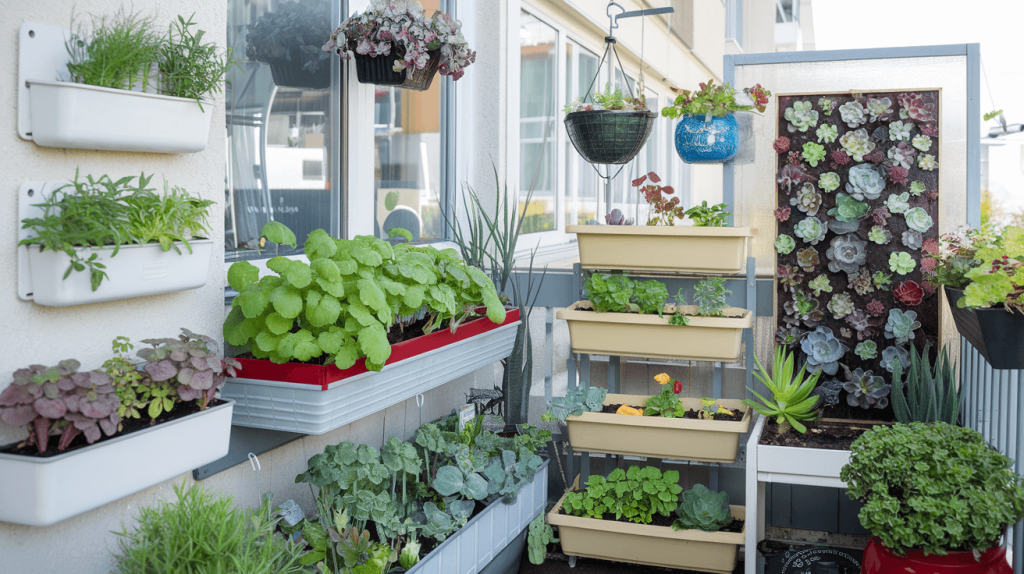
A. Compact vegetable varieties bred for container growing
Running low on space doesn’t mean giving up on fresh veggies. Plant breeders have created amazing compact varieties that pack full-sized flavor into tiny packages.
‘Patio’ tomatoes grow just 2 feet tall but produce plump, juicy fruits all summer long. ‘Bush Pickle’ cucumbers stay compact while delivering crisp cukes perfect for snacking or pickling. ‘Fairy Tale’ eggplants offer sweet, tender fruits on plants barely 18 inches tall.
Don’t overlook ‘Tom Thumb’ lettuce – it forms perfect 4-inch heads that fit anywhere. And ‘Romeo’ carrots mature at just 4 inches long, making them perfect for shallow containers.
The trick? These plants were specifically designed for container life. They won’t sprawl, climb, or demand endless root space like their full-sized cousins.
B. Dwarf fruit trees that thrive in pots
Yes, you can grow actual fruit trees in containers! Genetic dwarfing and special rootstocks create mini trees that produce full-sized harvests.
Citrus varieties like Meyer lemon and Calamondin orange naturally stay small while fruiting heavily. ‘Colonnade’ apple trees grow straight up instead of out, producing full-sized apples on a 8-foot tall column.
Fig trees like ‘Petite Negra’ and ‘Little Miss Figgy’ naturally stay under 6 feet while producing sweet, full-sized figs twice yearly.
Container peaches? Absolutely! ‘Bonanza’ peaches reach just 5 feet tall but produce full-sized juicy peaches that taste incredible.
C. Space-efficient herbs that provide maximum yield
Herbs are small-space superstars that keep giving all season long.
Basil, mint, and oregano can be harvested repeatedly – the more you cut, the more they grow. One 8-inch pot of thyme provides enough seasoning for dozens of meals.
Vertical herbs like rosemary and lavender grow up rather than out. Try stacking herbs in tiered planters to multiply your growing space.
Chives, parsley and cilantro happily share containers with other plants, making use of edges while letting taller plants have the center stage.
D. Ornamental plants that serve multiple purposes in tight spaces
Why waste precious space on plants that just look pretty? Multi-taskers are the way to go.
Nasturtiums offer gorgeous flowers plus edible leaves and seed pods with a peppery kick. Blueberry bushes provide spring flowers, summer fruit, and spectacular fall color.
‘Bright Lights’ Swiss chard delivers vibrant stems in yellow, pink, and red that look stunning while providing nutritious greens for months.
Dwarf sunflowers like ‘Teddy Bear’ attract pollinators, provide cheerful color, and offer edible seeds in just 2 square feet of space.
Even climbing roses can earn their keep – train them vertically to create living privacy screens while enjoying their beauty and fragrance.
Space-Maximizing Garden Design Strategies
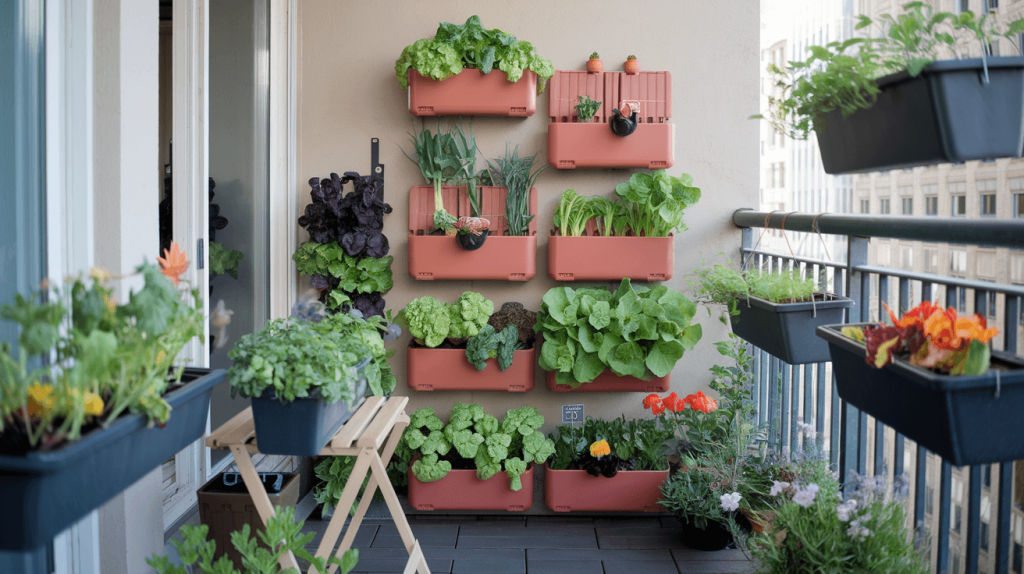
Vertical Growing Techniques That Multiply Your Garden Footprint
Think your tiny garden means tiny harvests? Not even close.
Vertical growing is a game-changer when you’re working with postage-stamp-sized spaces. Wall-mounted planters turn boring walls into food-producing powerhouses. I installed a simple trellis system on my apartment balcony last summer and managed to grow 15 pounds of cucumbers in just 2 square feet of floor space.
Try these vertical wins:
- Wall pockets: Fabric pouches that hang on any vertical surface
- Pallet gardens: Upcycled wooden pallets stood upright
- Tiered planters: Staggered systems that create multiple growing levels
- Hanging baskets: Not just for flowers—strawberries thrive in these
For climbing plants, give them something to grab onto. Cucumbers, peas, and beans practically beg for a lattice or string system. Even squash can grow vertically with proper support for the fruits.
Companion Planting Methods to Boost Yields in Small Areas
Smart pairing is everything in tight quarters.
Companion planting isn’t just garden folklore—it’s science that maximizes your harvest. When you pair plants strategically, they actually help each other grow better.
The classic “Three Sisters” method (corn, beans, squash) works because corn provides structure, beans fix nitrogen, and squash leaves shade the soil. But in small spaces, you need more targeted combos:
| Plant | Perfect Partner | Benefit |
|---|---|---|
| Basil | Tomatoes | Improves flavor, repels flies |
| Marigolds | Anything | Deters pests from entire garden |
| Carrots | Onions | Onion scent confuses carrot flies |
| Lettuce | Tall plants | Uses shade that would be wasted |
I’ve noticed my herbs grow 30% faster when planted near compatible vegetables rather than isolated in separate containers.
Succession Planting Schedules for Continuous Harvests
One-and-done gardening wastes precious space.
Succession planting turns your small garden into a non-stop food factory. Instead of harvesting everything at once, you stagger your plantings for continuous yields.
Quick-growing crops are your secret weapon here. Radishes mature in just 3-4 weeks—plant a new batch every two weeks for constant supply. Same goes for lettuce, spinach, and arugula.
My personal succession schedule:
- Early spring: Peas and spinach
- Late spring: When harvesting spring crops, plant summer beans and cucumbers
- Midsummer: Start fall kale and chard as summer crops peak
- Late summer: Plant quick-growing greens as summer crops finish
- Fall: Cold-hardy crops extend your season
I’ve managed to harvest something from my tiny 4×6 foot balcony garden every single week from April through November using this method.
Multi-Tiered Garden Layouts That Create Growing Zones
Thinking in 3D transforms your growing potential.
Multi-tiered gardens create different microclimates in one small footprint. Tall plants (tomatoes, peppers) go in the back, medium plants (bush beans, chard) in the middle, and ground-hugging plants (lettuce, carrots) in front.
This approach does more than save space—it creates growing zones based on:
- Sun exposure: Taller plants provide afternoon shade for greens
- Root depth: Shallow-rooted plants share soil with deep-rooted ones
- Growing season: Cool-season crops beneath summer vegetables
My favorite multi-tier setup uses step shelving against a south-facing wall. The bottom tier grows shade-lovers like lettuce, the middle holds herbs and peppers, and the top showcases sun-worshipping tomatoes.
For super-tight spaces, pyramid planters work wonders—I’ve grown 18 strawberry plants in a pyramid planter that takes up just 2 square feet of floor space.
Essential Small-Space Soil and Fertilizer Management
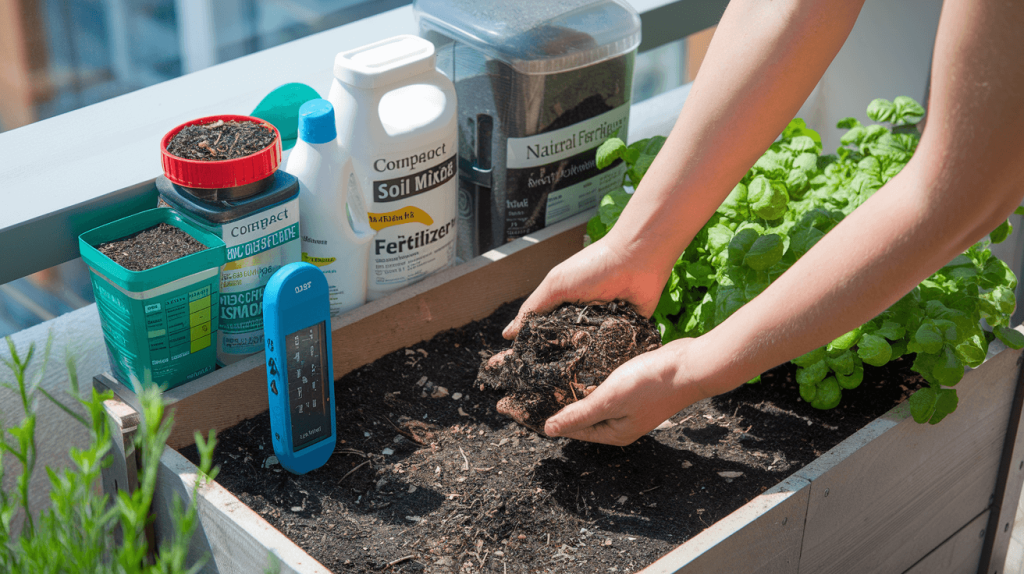
A. Container-specific soil mixes that promote healthy root development
Ever tried growing plants in regular garden soil stuffed in containers? Total disaster. Your plants just sit there, sulking.
The secret to container success is using the right soil mix. Regular potting soil doesn’t cut it for small spaces where every inch counts. Instead, go for lightweight, well-draining mixes specifically designed for containers.
I’ve found that the perfect container mix includes:
- 50% quality potting soil (not garden soil!)
- 30% coco coir or peat moss
- 20% perlite or vermiculite
This combo gives you soil that holds moisture without getting soggy, allows roots to breathe, and won’t compact over time. For vegetables, add a bit more organic matter. For succulents, throw in extra perlite or coarse sand.
You can also customize your mix based on what you’re growing:
| Plant Type | Soil Mix Adjustment |
|---|---|
| Herbs | Add extra sand for drainage |
| Tomatoes | Mix in more compost (about 25%) |
| Flowers | Incorporate slow-release fertilizer |
B. Space-efficient composting methods for apartment dwellers
No yard? No problem. Small-space composting is totally doable.
Bokashi composting is a game-changer for apartment dwellers. This Japanese method uses a special bran with microorganisms to ferment kitchen scraps in an airtight bucket. No smell, no mess, and it breaks down everything – even meat and dairy! Keep it under your sink and nobody will know it’s there.
Worm bins (vermicomposting) are another apartment-friendly option. These little workers turn your food scraps into black gold in weeks. A bin the size of a shoebox can process scraps from a small household and fits neatly under the kitchen sink.
Don’t want critters? Try a compact tumbling composter for your balcony. A quick spin every few days aerates the mix without any digging or turning.
My apartment hack: freezing scraps until you have enough to process. This prevents odors and fruit flies while you collect enough material.
C. Slow-release fertilizer options for consistent nutrition
Container plants are like hungry teenagers – they need constant feeding but hate being nagged about it.
Slow-release fertilizers are your set-it-and-forget-it solution. These clever pellets release nutrients gradually when you water, giving your plants a steady diet instead of feast-or-famine cycles.
Organic options I swear by:
- Osmocote pellets (mix into soil when planting)
- Worm castings (the Rolls-Royce of organic fertilizers)
- Compost tea bags (hang these in your watering can)
- Time-release organic spikes (push into soil every 2-3 months)
For container gardens, I’ve found that combining methods works best – a base of slow-release granules in your soil, topped up with liquid fertilizer at half-strength every few weeks.
The real trick is matching the fertilizer to your plants. Leafy greens want nitrogen-heavy food, while flowering plants need phosphorus to bloom their hearts out.
D. Water-retaining amendments that reduce maintenance needs
Small container gardens dry out faster than you can say “I forgot to water again.”
Water-retaining amendments will save your plants (and your sanity). Here are my top picks:
Coconut coir is my absolute favorite – it holds up to 10 times its weight in water while still letting roots breathe. Unlike peat moss, it’s renewable and sustainable.
Polymer moisture crystals expand when wet and slowly release water as soil dries. A little goes a long way – just a teaspoon per gallon of soil mix.
Biochar is the cool new kid on the block. This charcoal-like substance not only holds water but creates little microbe condos in your soil, improving overall soil health.
My secret weapon? A layer of pebbles or aquarium gravel at the bottom of containers, topped with a piece of landscape fabric. This creates a reservoir that roots can tap into when they need a drink.
E. Organic solutions for pest management in close quarters
Dealing with pests in small spaces is tricky – you can’t exactly blast everything with chemicals when you’re living right next to your plants.
Companion planting is your first line of defense. Marigolds repel aphids, basil keeps flies away from tomatoes, and nasturtiums act as trap crops for caterpillars. Pretty and practical!
For active infestations, try these organic solutions:
- Neem oil spray for almost everything (mix 1 tsp neem oil, 1/2 tsp mild soap, 1 quart water)
- Diatomaceous earth sprinkled on soil for crawling insects
- Sticky traps for fungus gnats (those annoying little flies in houseplants)
- Insecticidal soap for soft-bodied pests like aphids and mealybugs
Prevention beats treatment every time. Check new plants thoroughly before bringing them home – they’re often trojan horses for pests. And don’t forget to rotate your crops, even in containers. Growing the same plant in the same soil year after year is basically sending pests an invitation.
Water-Wise Techniques for Container Gardens
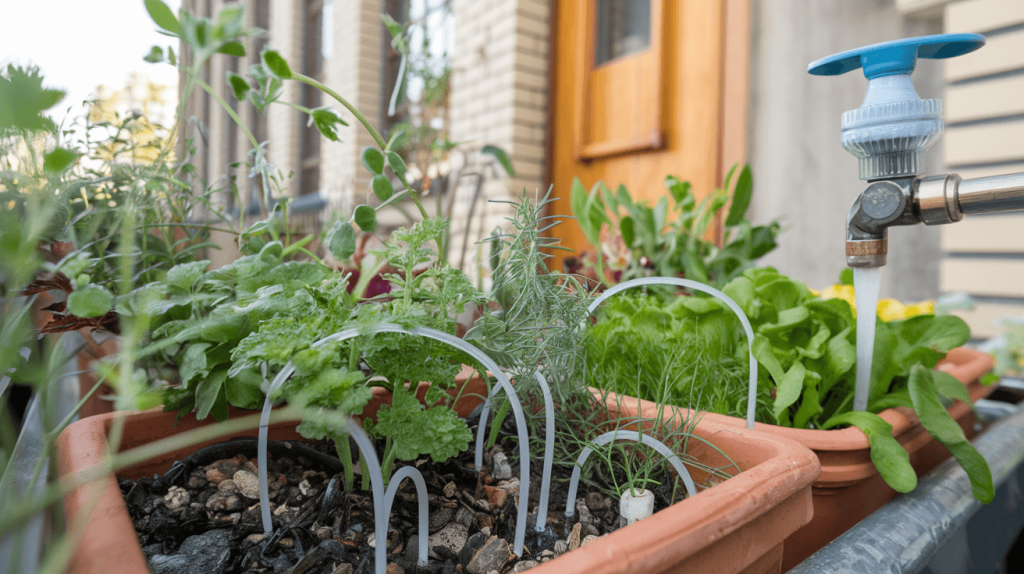
Self-watering systems that save time and resources
Ever been on vacation only to return to crispy, dead plants? Been there. Self-watering containers are absolute game-changers for busy gardeners with small spaces.
These clever systems use a reservoir at the bottom of the pot that slowly releases water to your plants as needed. The beauty? Your plants take exactly what they need, when they need it.
You’ve got options:
- Store-bought self-watering pots: A bit pricier but super convenient
- DIY versions: Use a plastic bottle, some string, and a drill for a weekend project that costs next to nothing
- Wicking beds: Place absorbent material between the reservoir and soil to draw moisture upward
I converted most of my container garden to self-watering systems last year and cut my water usage by almost 40%. Plus, my tomatoes stopped splitting from inconsistent watering.
Drip irrigation setups for efficient moisture distribution
Drip irrigation might sound fancy, but it’s just a smart way to deliver water directly to your plants’ roots. And it’s perfect for small spaces.
A basic drip system consists of:
- A timer attached to your faucet
- Main tubing that runs along your containers
- Smaller tubes or emitters that deliver water to each plant
What makes drip irrigation magic for small spaces? It targets only what needs watering. No more spraying your patio or balcony walls!
You can set up a complete system for under $50, and modern kits come with easy snap-together parts. No plumbing degree required.
The real win is in the water savings—drip systems use up to 70% less water than traditional watering methods while giving your plants consistent moisture.
Rain collection methods for sustainable garden maintenance
Why pay for water when the sky gives it away for free? Even in tiny spaces, you can harvest rainwater.
Small-space rain collection doesn’t require massive barrels. Try these options:
- Collapsible rain barrels: These fold flat when not in use but expand to hold 50+ gallons during rainy periods
- Rain chains: Guide water from gutters into containers while looking decorative
- Window box diverters: Attach to downspouts to fill watering cans automatically
Plants actually prefer rainwater because it’s free of chemicals like chlorine and has a perfect pH. Your container plants will thank you.
One caution: check local regulations first. Some areas have restrictions on rainwater harvesting (which is silly, but rules are rules).
Moisture monitoring tools that prevent overwatering
Overwatering kills more container plants than underwatering. No joke. But how do you know when enough is enough?
The tech world has blessed us with some pretty cool gadgets:
- Moisture meters: Simple probes that tell you when soil is dry, moist, or wet
- Smart sensors: Connect to your phone and send alerts when plants need water
- Terracotta stakes: Low-tech options that change color as soil dries out
- The finger test: Still the most reliable method—stick your finger an inch into the soil. If it’s dry, water. If not, wait.
For my container herbs, I use a $10 moisture meter that’s lasted three seasons. The peace of mind alone was worth the investment.
Remember that different plants have different moisture needs. Succulents want to dry out completely between waterings, while leafy greens prefer consistent moisture.
Maximizing Sunlight in Challenging Urban Environments
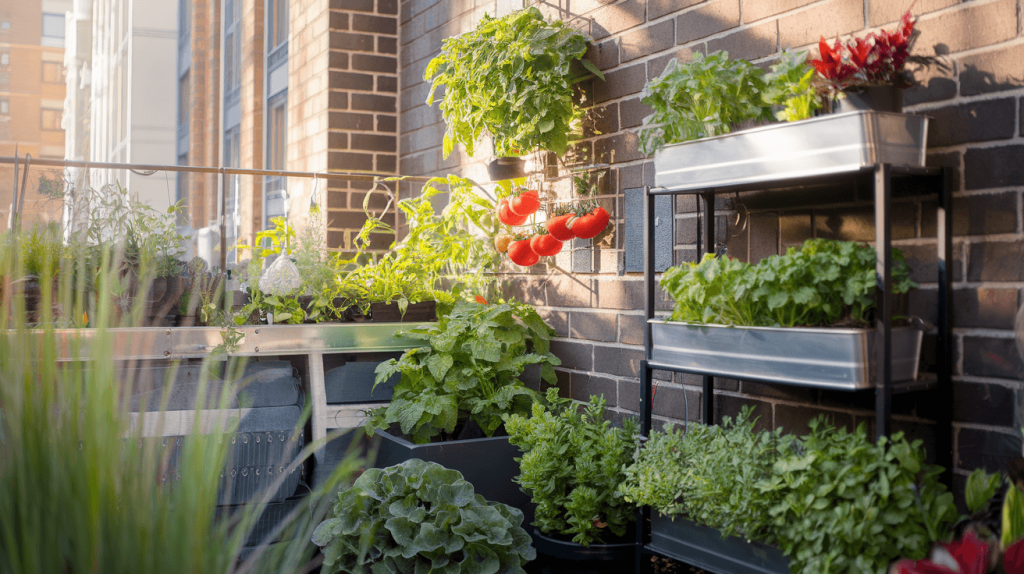
Light-mapping Techniques to Identify Optimal Growing Spots
Living in the concrete jungle doesn’t mean giving up on your garden dreams. The secret? Understanding where the sunshine actually lands.
Grab a notebook and track sunlight patterns throughout the day. Sounds tedious? It is—but so worth it. Mark sunny spots at 9am, noon, 3pm, and 6pm for a few days. You’ll quickly see patterns emerge that your plants will thank you for.
For the tech-savvy urban gardeners out there, several apps now do the heavy lifting. SunSeeker and Sun Surveyor map the sun’s path across your space, showing you exactly where those golden rays will hit throughout the year. No guesswork needed.
Got a particularly tricky space? Try the old-school “sun map” method:
- Draw a rough outline of your space
- Place a marker in potential planting spots
- Check every hour from dawn to dusk, marking “S” for sunny, “PS” for partial sun, and “SH” for shade
- After a day, you’ll have your personalized growing guide
The spots getting 6+ hours of direct sunlight? That’s prime real estate for your tomatoes and peppers. Those 3-5 hour spots? Perfect for leafy greens and herbs.
Reflective Materials That Amplify Available Sunlight
Urban gardeners, listen up. You can literally bounce more sunshine onto your plants.
White-painted walls or fences behind your garden aren’t just pretty—they’re functional light reflectors. The difference can be dramatic, sometimes adding the equivalent of an extra hour of sunlight to plants positioned nearby.
Aluminum foil mounted on cardboard creates instant, movable light reflectors. Position these behind plants that need a sunshine boost, especially in morning or late afternoon when sun angles are lower.
For something more permanent and weather-resistant, try:
| Reflective Material | Light Boost | Best For |
|---|---|---|
| Mylar sheeting | 90-95% reflection | Serious light-deprived areas |
| White plastic | 70-80% reflection | Rainy climates (water-resistant) |
| Metallic paint | 60-75% reflection | Decorative garden features |
| Mirror tiles | 80-90% reflection | Small, targeted areas |
Strategic placement matters more than quantity. Position reflectors on the north side of plants (in northern hemisphere) to catch and redirect sunlight without cooking your precious seedlings.
Shade-Tolerant Plant Selections for Less Sunny Spaces
Not every corner of your tiny urban oasis gets bathed in sunlight—and that’s totally fine. Some plants actually prefer the shade and will thrive where others would struggle.
Leafy greens are your shade garden heroes. Spinach, kale, and arugula actually taste better when grown in cooler, shadier spots. They’re less likely to bolt (go to seed) and turn bitter.
For those decorative touches, these shade-lovers bring serious beauty to dim corners:
- Hostas – those gorgeous variegated leaves need zero direct sun
- Impatiens – constant blooms with just 2-4 hours of filtered light
- Coleus – practically glows with vibrant foliage patterns in deep shade
- Ferns – the ultimate shade specialists, bringing lush texture to dark spots
Herbs that rock the shade include mint (which will take over if you let it), parsley, and cilantro. These culinary staples actually prefer protection from harsh afternoon sun.
The secret most gardening books won’t tell you? Many “full sun” plants can adapt to partial shade—they might grow slower or produce fewer blooms/fruits, but they won’t die. Experiment with cherished plants in spots getting at least 4 hours of sun.
Seasonal Adjustments to Capitalize on Changing Light Patterns
The sun plays hide-and-seek throughout the year, completely transforming your tiny garden’s growing potential. Smart urban gardeners roll with these changes instead of fighting them.
Summer brings high, intense sun but also deeper shadows. This is when those reflective materials truly earn their keep. Position them to bounce light into dark corners during peak growing season.
During spring and fall, the sun sits lower in the sky. Those spots that were shaded all summer might suddenly get perfect growing light! Keep containers mobile so you can chase these seasonal sun pockets.
Winter’s anemic sunshine requires ruthless prioritization. Move your most light-hungry plants to south-facing windows or spots that catch those precious few hours of direct light.
Consider this seasonal planting approach:
- Spring: Quick-growing crops everywhere as light increases
- Summer: Heat-lovers in brightest spots, leafy greens in dappled shade
- Fall: Root vegetables and hardy greens as light diminishes
- Winter: Focus on microgreens indoors or under lights
The smart move? Create a seasonal sun map for each major transition. What was a perfect tomato spot in July might be ideal for spinach by September.
Trellises and climbing plants? Adjust their position seasonally. A vine that provided cooling shade in August can be relocated to allow more light penetration during cooler months.
Maintaining Garden Health in Close Quarters
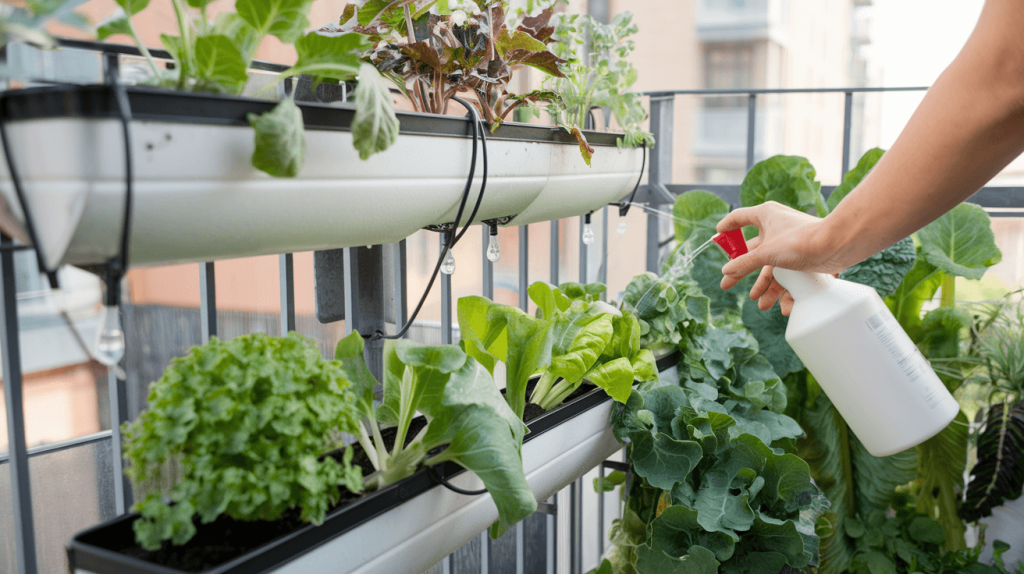
Preventing disease spread in densely planted spaces
Cramming plants together in a small garden seems like a smart space-saving move until fungal diseases start spreading like neighborhood gossip. I’ve learned this the hard way—twice.
The secret? Give those plants some breathing room, even in tight quarters. Space them according to the seed packet recommendations, not your ambitious garden dreams. If the packet says 12 inches apart, don’t try to squeeze them to 6.
Water at the base of plants, not overhead. Wet leaves in crowded conditions? That’s basically sending out party invitations to powdery mildew and other fungi. Early morning watering helps too—leaves dry before nightfall when most fungi like to party.
Mulch is your tiny garden’s best friend. A 2-inch layer stops soil from splashing onto leaves during rain, cutting disease transmission dramatically. Plus, it keeps weeds down, and who has space for weeds in a small garden?
Pruning techniques that improve airflow and plant vigor
Smart pruning transforms a cramped garden from a stagnant, disease-prone mess into a thriving ecosystem. The trick isn’t just cutting—it’s strategic removal.
First, identify crossing branches and interior growth that block air movement. These are your primary targets. When plants get tangled together in small spaces, humidity gets trapped, creating perfect conditions for fungal problems.
For tomatoes in tight spaces (a small-space gardening favorite), focus on removing lower leaves and suckers. This “bottom-up” approach dramatically improves air circulation where it matters most while directing energy to fruit production.
Don’t be timid with herbs! Regular harvesting is actually a form of pruning that encourages bushier, more productive growth. Pinch basil tops when plants reach 6 inches tall and watch them explode with new growth—doubling your yield in the same tiny footprint.
Early detection systems for pest management
The smaller your garden, the faster pests can take over. One aphid-covered plant can quickly infect everything when plants are just inches apart.
Create a simple early warning system: yellow sticky cards placed strategically throughout your garden catch flying pests before they establish colonies. Check them weekly—they’re like little pest report cards.
Get into the habit of flipping leaves during morning coffee. Look under leaves and inside flower buds where trouble starts. Those tiny specks that moved? Spider mites beginning their takeover. That slight leaf discoloration? Probably nutrient issues or early disease.
Digital microscopes that connect to smartphones are game-changers for small space gardeners. For under $30, you can magnify suspicious spots and identify problems before they become disasters. I’ve saved entire herb collections by catching spider mites two days before they would’ve destroyed everything.
Plant rotation strategies for small space soil health
Think crop rotation is only for farmers with acres of land? Think again. Even in containers and tiny plots, rotating plant families prevents soil-borne diseases and nutrient depletion.
Create a simple 3-year rotation plan, even if your “garden” is just a collection of pots on a balcony. Move nightshades (tomatoes, peppers) to where leafy greens grew last year. Put legumes where root vegetables were. Your soil microbiome will thank you.
Keep a garden map—no matter how small your space. One square foot planted with the same crop family year after year becomes a breeding ground for specialized pests and diseases.
For container gardens, refresh at least the top third of soil annually and rotate what you plant there. Better yet, completely replace soil in containers every two years. It’s the small space gardener’s version of crop rotation and it makes a massive difference in plant health and productivity.

Growing a flourishing garden in a small space is not only possible but can be incredibly rewarding with the right approach. By selecting appropriate containers, choosing compact or vertical-growing plants, and implementing smart design strategies, you can transform even the tiniest balcony or windowsill into a green oasis. Proper soil management, water-wise techniques, and maximizing available sunlight are equally important foundations for your small-space garden’s success.
Remember that urban gardening is as much about creativity as it is about horticultural knowledge. Start small, experiment with different solutions that work for your specific space constraints, and don’t be afraid to adjust your approach as you learn. With patience and these targeted strategies, your small-space garden will not only survive but truly thrive, bringing beauty, fresh produce, and a connection to nature right to your doorstep—no matter how limited your square footage might be.

